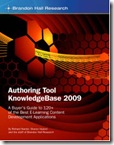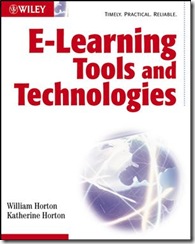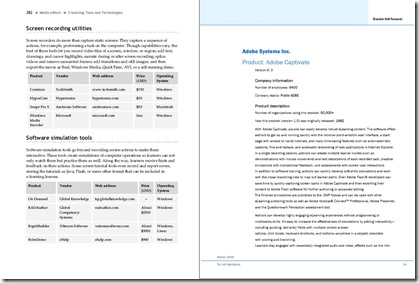The number of tools and technologies for online training continues to grow. Despite economies being mired in a recession, literally hundreds of e-learning content authoring tools, learning management systems, and learning content management systems are being offered in the marketplace.
 Brandon Hall Research, domain analysts for the e-learning industry and providers of information about tools, technologies, and best practices related to employee training and enterprise learning have just released a comprehensive new guide called Authoring Tool KnowledgeBase 2009: A Buyer's Guide to 120+ of the Best E-Learning Content Development Applications.
Brandon Hall Research, domain analysts for the e-learning industry and providers of information about tools, technologies, and best practices related to employee training and enterprise learning have just released a comprehensive new guide called Authoring Tool KnowledgeBase 2009: A Buyer's Guide to 120+ of the Best E-Learning Content Development Applications.
According to their press release, "the current edition of this online, database-driven KnowledgeBase contains 10-20 page profiles of 122 content development tools" including:
- 65 products to create online courses
- 26 products to create online tests and assessments
- 20 products to create software simulations
- 23 products to help you convert your legacy content to e-learning
- 9 products to create non-software simulations
- 8 products to create instructional games
They also include two online software applications:
- A selection tool that helps you narrow your product search by filtering out the tools that don't meet your needs
- A comparison tool to help you see how two similar products differ
I recently published an article called What's on your e-learning bookshelf? In it, I listed my shelf of “go to” e-learning texts. I've re-published the picture of my shelf below, so that you can see, right there in the middle, a text called E-learning Tools and Technologies by Horton and Horton.
In the early part of this decade learning and development professionals and educators found this text to be an invaluable reference resource. If you had a requirement to understand a new training modality or learning channel in a hurry (as many of us did in five or six years ago as we faster, better, and more integrated communications networks burgeoned) the Horton and Horton text was a good place to begin to find out about it.  However, as we reach the end of the decade, the tools and some of the technologies in text (I have the first edition) is looking decidedly dated; Blogger.com was still owned by Pyra Labs; podcasting is not given a look-in in any shape or form. As far as I could discern through a brief search (on Amazon, Wiley Books Online, and Google Books), the 2003 edition is still in print.
However, as we reach the end of the decade, the tools and some of the technologies in text (I have the first edition) is looking decidedly dated; Blogger.com was still owned by Pyra Labs; podcasting is not given a look-in in any shape or form. As far as I could discern through a brief search (on Amazon, Wiley Books Online, and Google Books), the 2003 edition is still in print.
The outcome of this is that while the text is still full of good advice, useful information, and valuable insight into topics associated with e-learning design, development and delivery, many of the products it highlights are deprecated (Authorware), redundant (GoLive), or changed beyond recognition (most products featured in the text). In my view this is where resources like the Brandon Hall KnowledgeBase come into their own. While, necessarily, the text and the information is not as rich as in the Horton and Horton book (see Figure 1 for a comparison between the layout of the two resources), it's competitive advantage is that is delivers bang up-to-date, regularly refreshed information, and a easy-to-use selection and comparison utility to choose and compare products.
Figure 1. Side-by-side of the texts: Horton (l), Brandon Hall (r)
[Click to enlarge]
In one sense, this is the threshold between the analog and digital forms of information delivery. Putting my cultural anthropology hat on for a moment, I would characterize this as a liminal state. Liminality has been described as "the place in between" (La Shure, 2009) infused with ambiguity, openness, and indeterminacy.
For example, as a university lecturer delivering a course on learning technology do I include E-Learning Tools and Technologies on the required reading list, or the more up-to-date Authoring Tool KnowledgeBase? How do I set a question on the information in the latter source as it is in one sense, just a list and description of products and their capabilities, with none of the context provided by the former text? Which is more "academic?" Does this reflect the text's accuracy? Is the cost ($795 annual subscription) of Brandon Hall membership justifiable for students, or people who just was occasional access to information, as opposed to about $40 for the out-of-date Horton and Horton text. How much is the information worth?
These are difficult questions to answer satisfactorily.
I have no doubt that over time, e-texts will become integrated into the mainstream of  academic, professional, and consumer activity. Online libraries like MyAthens already provide access to a range of electronically-available materials for a nominal fee to the individual user as membership to institutions, universities, and libraries.
academic, professional, and consumer activity. Online libraries like MyAthens already provide access to a range of electronically-available materials for a nominal fee to the individual user as membership to institutions, universities, and libraries.
E-readers like the Kindle, and e-book software like Lexcycle Stanza (recently purchased by Amazon) are beginning to provide the facility to view electronic versions of printed texts.
Maybe this electronic means of access will become more generalized; I use Stanza on my iPhone and it’s changing my reading habits. Perhaps the current practice of hard- and e-texts being used in concert will become firmly embedded as the most effective method of using the old and the new. As usual, people will do what works for them, and the usual rules for adoption of innovations will apply.
Yet the question remains: How out-of-date is too out-of-date?
I think that my Horton printed text still has great value, especially in the context it provides for e-elearning-related technologies; yet I can't rely on it to provide current information about specific e-learning authoring applications. With over ten years experience in the learning and development industry, I feel competent to apply my well-developed critical faculties to find out what I need from the range of knowledge and information at my disposal. Could I make my tacit, hard-earned ability to analyze, synthesize, and evaluate information available to some-one else? Probably not.
How do you use the resources at your disposal? I’d love to hear your views and about your experiences - let me know.
___________
References:
Brandon Hall Research. (2009). Authoring Tool KnowledgeBase 2009: A Buyer's Guide to 120+ of the Best E-Learning Content Development Applications. [Internet] Available from: http://www.brandon-hall.com/publications/atkb/atkb.shtml Accessed 29 June 2009
Horton, W., & Horton, K. (2003). E-learning Tools and Technologies: A consumer’s guide for trainers, teachers, educators, and instructional designers. Wiley Publishing, Inc., Indianapolis, Indiana
La Shure, C. (2009). Liminality. [Internet] Available from: http://www.liminality.org/about/whatisliminality/ Accessed 29 June 2009
--







No comments:
Post a Comment